Kuppan T. Heat Exchanger Design Handbook
Подождите немного. Документ загружается.

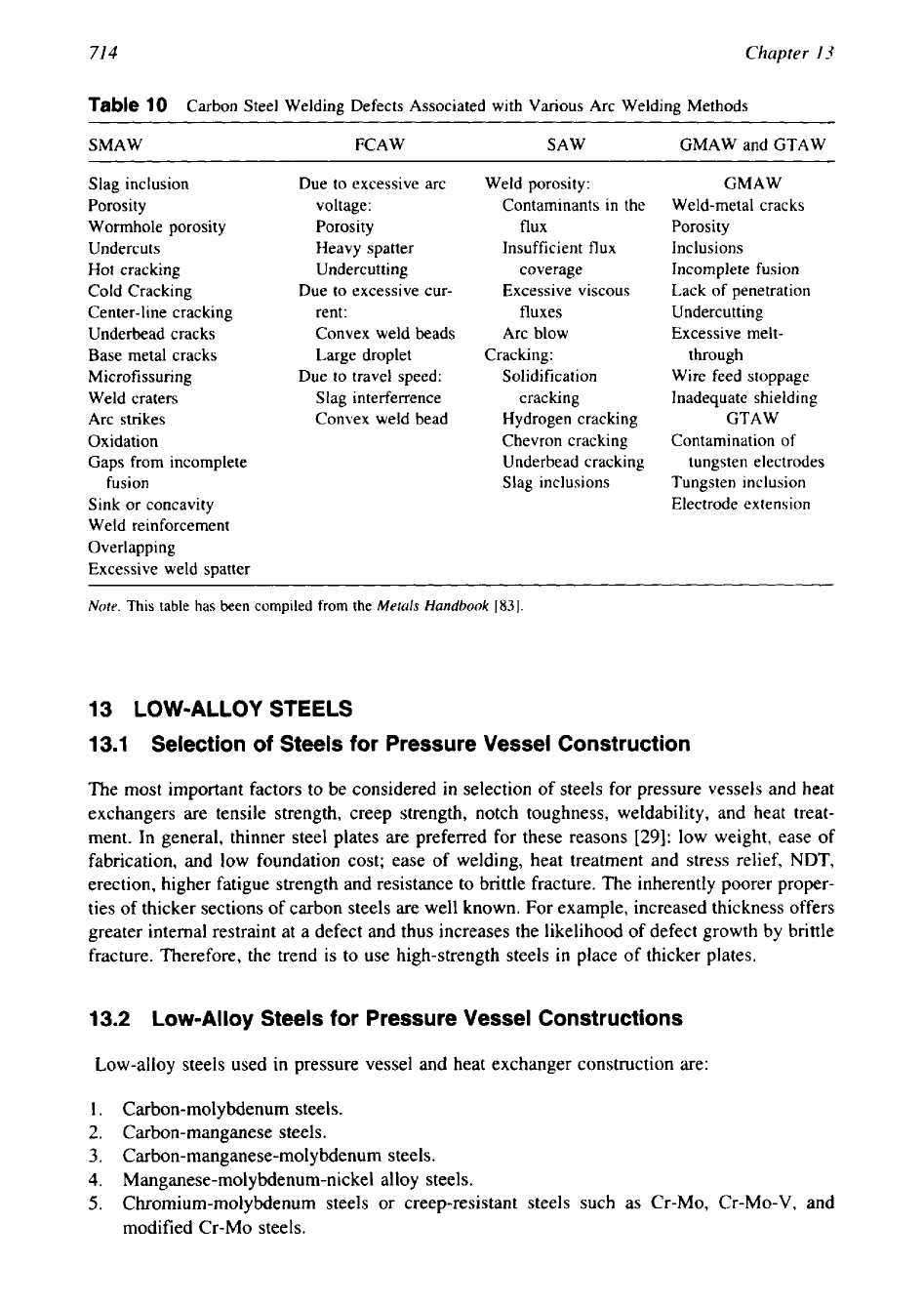
71
4
Chapter
I3
Table
10
Carbon Steel Welding Defects Associated with Various Arc Welding Methods
SMAW FCAW SAW GMAW and GTAW
Slag inclusion
Due to excessive arc
Weld porosity:
GMAW
Porosity
voltage:
Contaminants in the
Weld-metal cracks
Wormhole porosity
Porosity
flux
Porosity
Undercuts
Heavy spatter
Insufficient flux
Inclusions
Hot
cracking
Undercutting
coverage
Incomplete fusion
Cold Cracking
Due
to
excessive cur-
Excessive viscous
Lack of penetration
Center-line cracking
rent:
fluxes
Undercutting
Underbead cracks
Convex weld beads
Arc blow
Excessive melt-
Base metal cracks
Large droplet
Cracking:
through
Microfissuring
Due to travel speed:
Solidification
Wire feed stoppage
Weld craters
Slag
interferrence
cracking
Inadequate shielding
Arc strikes
Convex weld bead
Hydrogen cracking
GTAW
Oxidation
Chevron cracking
Contamination of
Gaps from incomplete
Underbead cracking
tungsten electrodes
fusion
Slag inclusions
Tungsten inclusion
Sink or concavity
Electrode ex tension
Weld reinforcement
Overlapping
Excessive weld spatter
Nore.
This table has been compiled
from
the
Met&
Handbook
[83].
13 LOW-ALLOY STEELS
13.1
Selection
of
Steels for Pressure Vessel Construction
The most important factors to be considered in selection of steels for pressure vessels and heat
exchangers are tensile strength, creep strength, notch toughness, weldability, and heat treat-
ment. In general, thinner steel plates are preferred for these reasons
[29]:
low weight, ease of
fabrication, and low foundation cost; ease of welding, heat treatment and stress relief,
NDT,
erection, higher fatigue strength and resistance to brittle fracture. The inherently poorer proper-
ties of thicker sections of carbon steels are well known. For example, increased thickness offers
greater internal restraint at a defect and thus increases the likelihood of defect growth by brittle
fracture. Therefore, the trend is to use high-strength steels
in
place
of
thicker plates.
13.2 Low-Alloy
Steels
for
Pressure Vessel Constructions
Low-alloy steels used in pressure vessel and heat exchanger construction are:
1.
Carbon-molybdenum steels.
2.
Carbon-manganese steels.
3. Carbon-manganese-molybdenum steels.
4.
Manganese-molybdenum-nickel alloy steels.
5.
Chromium-molybdenum steels or creep-resistant steels such as Cr-MO, Cr-MO-V, and
modified Cr-Mo steels.
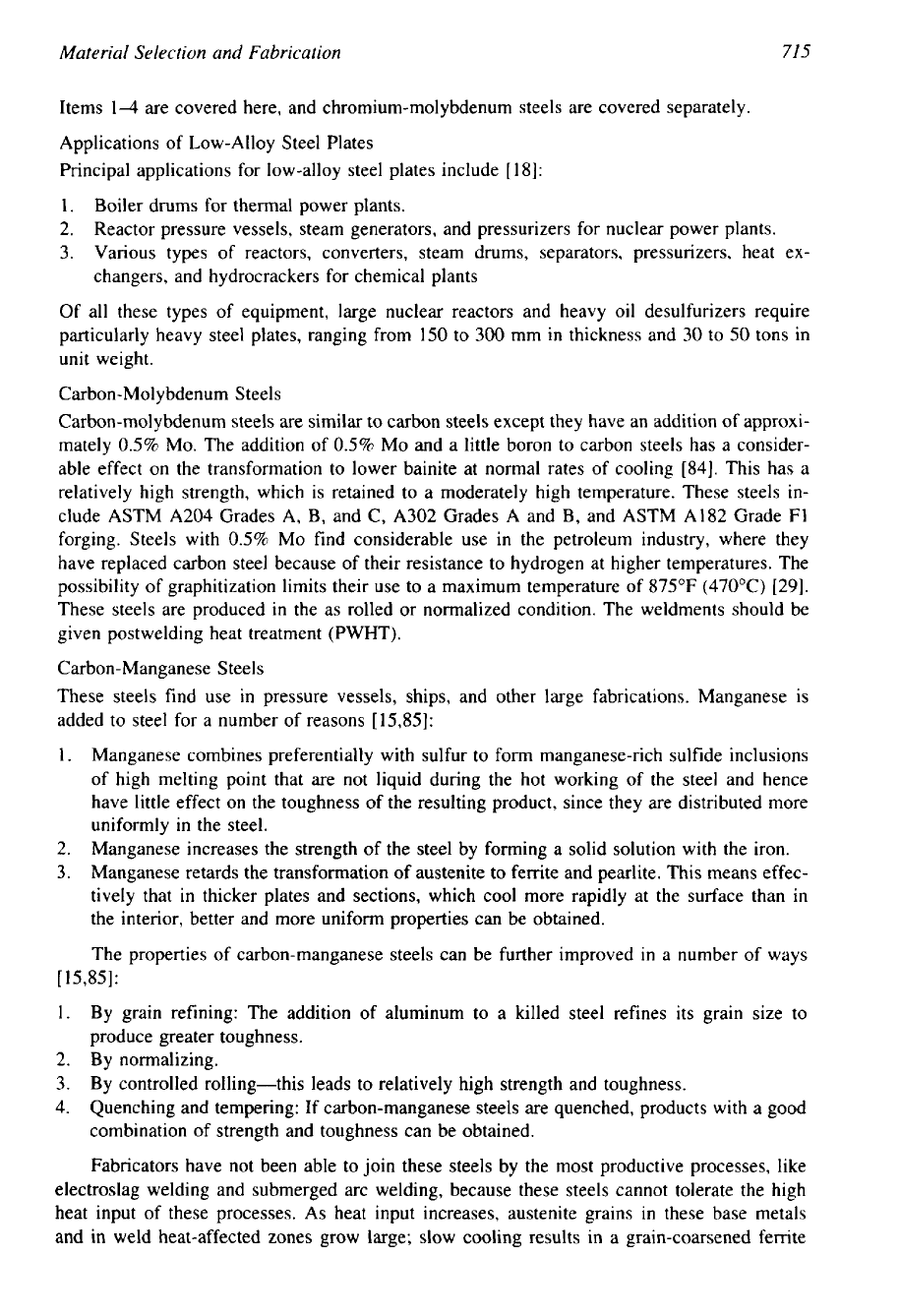
Material Selection and Fabrication
71
5
Items
1-4
are covered here, and chromium-molybdenum steels are covered separately.
Applications of Low-Alloy Steel Plates
Principal applications for low-alloy steel plates include
[
181:
1.
Boiler drums for thermal power plants.
2.
Reactor pressure vessels, steam generators, and pressurizers for nuclear power plants.
3.
Various types of reactors, converters, steam drums, separators, pressurizers, heat ex-
changers, and hydrocrackers for chemical plants
Of all these types of equipment, large nuclear reactors and heavy oil desulfurizers require
particularly heavy steel plates, ranging from
150
to
300
mm
in
thickness and
30
to
50
tons in
unit
weight.
Carbon-Molybdenum Steels
Carbon-molybdenum steels are similar to carbon steels except they have an addition of approxi-
mately
0.5%
MO. The addition of
0.5%
MO and a little boron to carbon steels has a consider-
able effect on the transformation to lower bainite at normal rates
of
cooling [84]. This has a
relatively high strength, which is retained to a moderately high temperature. These steels in-
clude ASTM A204 Grades
A,
B, and C, A302 Grades A and
B,
and ASTM A182 Grade
F1
forging. Steels with
0.5%
MO find considerable use in the petroleum industry, where they
have replaced carbon steel because of their resistance to hydrogen at higher temperatures. The
possibility of graphitization limits their use to a maximum temperature of 875°F (470°C) [29].
These steels are produced
in
the as rolled or normalized condition. The weldments should be
given postwelding heat treatment (PWHT).
Carbon-Manganese Steels
These steels find use in pressure vessels, ships, and other large fabrications. Manganese is
added to steel for a number of reasons
[15,85]:
1.
Manganese combines preferentially with sulfur to form manganese-rich sulfide inclusions
of high melting point that are not liquid during the hot working of the steel and hence
have little effect on the toughness of the resulting product, since they are distributed more
uniformly
in
the steel.
2.
Manganese increases the strength of the steel by forming a solid solution with the iron.
3.
Manganese retards the transformation of austenite to ferrite and pearlite. This means effec-
tively that in thicker plates and sections, which cool more rapidly at the surface than in
the interior, better and more uniform properties can be obtained.
The properties of carbon-manganese steels can be further improved in a number of ways
[15,85]:
1.
By grain refining: The addition of aluminum to a killed steel refines its grain size to
produce greater toughness.
2.
By normalizing.
3.
By controlled rolling-this leads to relatively high strength and toughness.
4.
Quenching and tempering: If carbon-manganese steels are quenched, products with a good
combination of strength and toughness can be obtained.
Fabricators have not been able to join these steels by the most productive processes, like
electroslag welding and submerged arc welding, because these steels cannot tolerate the high
heat input of these processes. As heat input increases, austenite grains in these base metals
and in weld heat-affected zones grow large; slow cooling results in a grain-coarsened ferrite
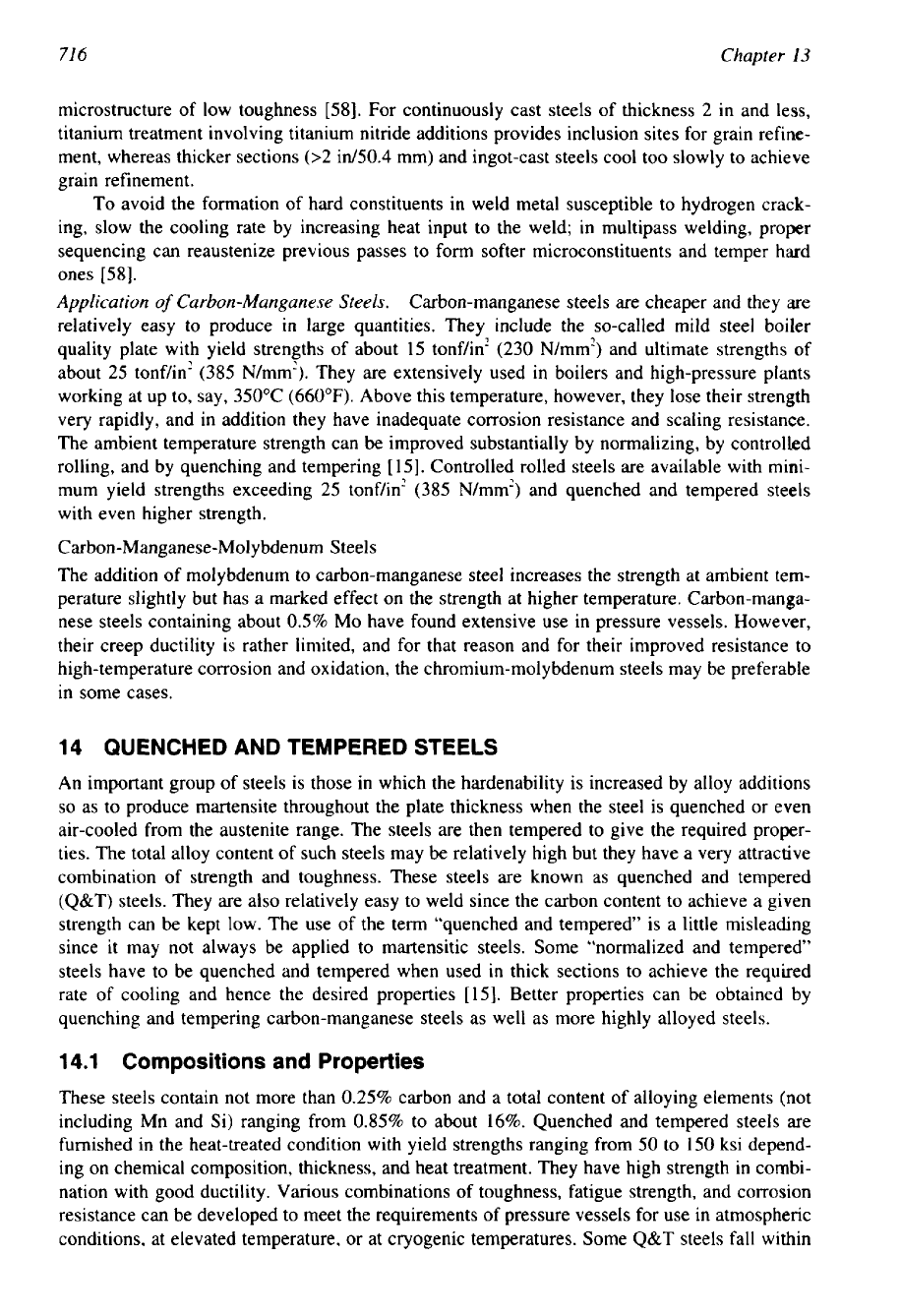
71
6
Chapter
13
microstructure of low toughness [58]. For continuously cast steels of thickness
2
in
and less,
titanium treatment involving titanium nitride additions provides inclusion sites for grain refine-
ment, whereas thicker sections
(>2
in/50.4 mm) and ingot-cast steels cool too slowly to achieve
grain refinement.
To avoid the formation of hard constituents in weld metal susceptible to hydrogen crack-
ing, slow the cooling rate by increasing heat input to the weld; in multipass welding, proper
sequencing can reaustenize previous passes to form softer microconstituents and temper hard
ones [58].
Application
of
Carbon-Manganese Steels.
Carbon-manganese steels are cheaper and they are
relatively easy to produce in large quantities. They include the so-called mild steel boiler
quality plate with yield strengths of about
15
tonf/in2
(230
N/mmz) and ultimate strengths of
about
25
tonf/in‘
(385
N/mm’). They are extensively used in boilers and high-pressure plants
working at up to, say, 350°C
(660°F).
Above this temperature, however, they lose their strength
very rapidly, and in addition they have inadequate corrosion resistance and scaling resistance.
The ambient temperature strength can be improved substantially by normalizing, by controlled
rolling, and by quenching and tempering
[15].
Controlled rolled steels are available with mini-
mum yield strengths exceeding
25
tonf/in‘ (385 N/mm‘) and quenched and tempered steels
with even higher strength.
Carbon-Manganese-Molybdenum Steels
The addition of molybdenum to carbon-manganese steel increases the strength at ambient tem-
perature slightly but has a marked effect on the strength at higher temperature. Carbon-manga-
nese steels containing about
0.5%
MO have found extensive use in pressure vessels. However,
their creep ductility is rather limited, and for that reason and for their improved resistance to
high-temperature corrosion and oxidation, the chromium-molybdenum steels may be preferable
in some cases.
14
QUENCHED AND TEMPERED STEELS
An important group of steels is those in which the hardenability is increased by alloy additions
so
as to produce martensite throughout the plate thickness when the steel is quenched or even
air-cooled from the austenite range. The steels are then tempered to give the required proper-
ties. The total alloy content of such steels may be relatively high but they have
a
very attractive
combination of strength and toughness. These steels are known as quenched and tempered
(Q&T) steels. They are also relatively easy to weld since the carbon content to achieve a given
strength can be kept low. The use of the term “quenched and tempered” is a little misleading
since it may not always be applied to martensitic steels. Some “normalized and tempered”
steels have to be quenched and tempered when used in thick sections to achieve the required
rate of cooling and hence the desired properties [15]. Better properties can be obtained by
quenching and tempering carbon-manganese steels as well as more highly alloyed steels.
14.1
Compositions and Properties
These steels contain not more than
0.25%
carbon and a total content of alloying elements (not
including Mn and Si) ranging from 0.85% to about
16%.
Quenched and tempered steels are
furnished in the heat-treated condition with yield strengths ranging from
50
to
150
ksi depend-
ing on chemical composition, thickness, and heat treatment. They have high strength in combi-
nation with good ductility. Various combinations of toughness, fatigue strength, and corrosion
resistance can be developed to meet the requirements of pressure vessels for use in atmospheric
conditions, at elevated temperature, or at cryogenic temperatures. Some
Q&T
steels fall within
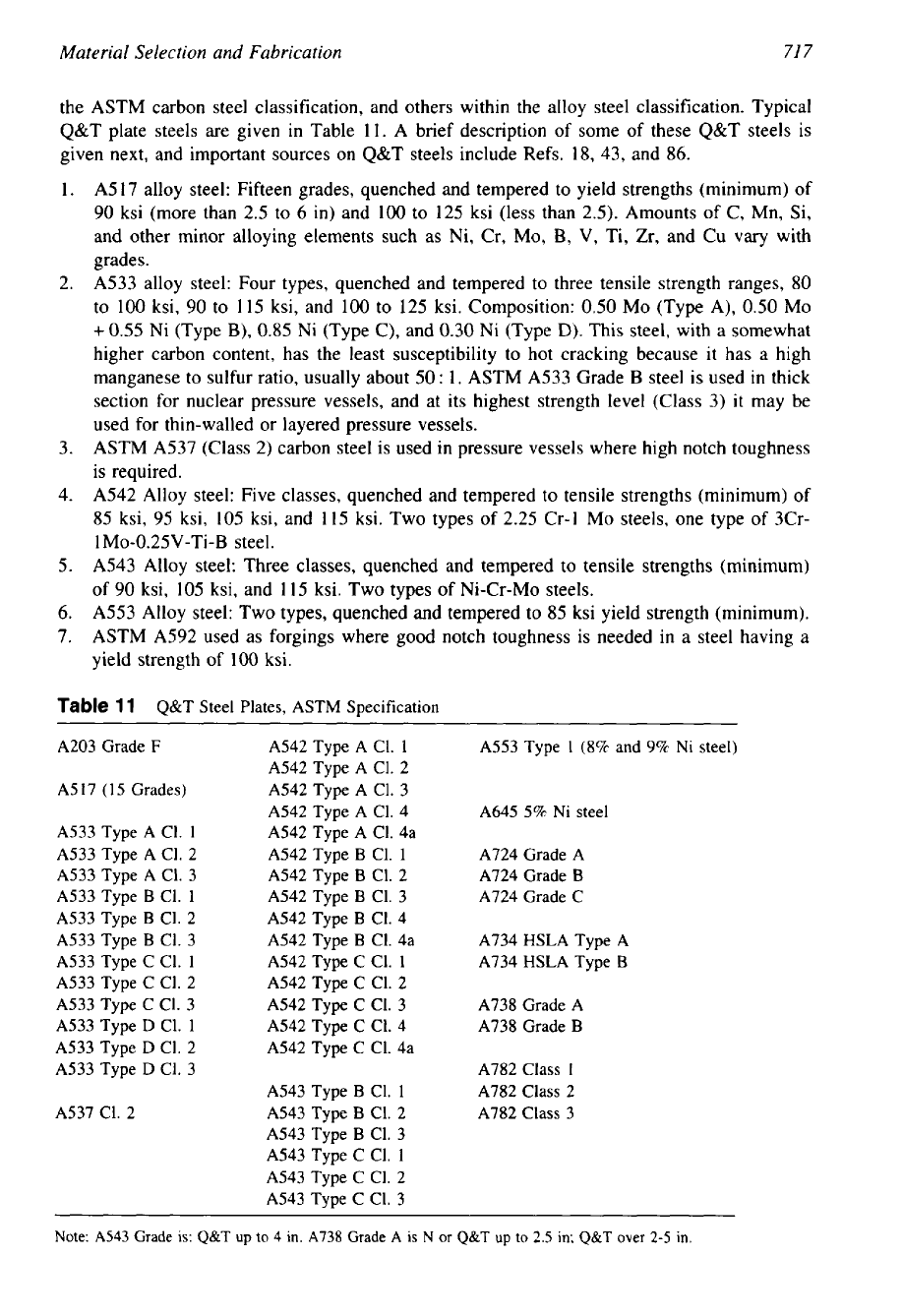
Material Selection and Fabrication
71
7
the ASTM carbon steel classification, and others within the alloy steel classification. Typical
Q&T plate steels are given in Table 11. A brief description of some of these Q&T steels is
given next, and important sources on Q&T steels include Refs. 18, 43, and
86.
1.
A517 alloy steel: Fifteen grades, quenched and tempered to yield strengths (minimum) of
90 ksi (more than 2.5 to
6
in) and
100
to 125 ksi (less than 2.5). Amounts of C, Mn, Si,
and other minor alloying elements such as Ni, Cr,
MO,
B,
V, Ti, Zr, and Cu vary with
grades.
2.
A533 alloy steel: Four types, quenched and tempered to three tensile strength ranges,
80
to 100 ksi, 90 to 115 ksi, and 100 to 125 ksi. Composition: 0.50 MO (Type A), 0.50 MO
+
0.55
Ni (Type
B),
0.85 Ni (Type C), and
0.30
Ni (Type
D).
This steel, with a somewhat
higher carbon content, has the least susceptibility to hot cracking because
it
has a high
manganese to sulfur ratio, usually about
50
:
1.
ASTM A533 Grade
B
steel is used in thick
section for nuclear pressure vessels, and at its highest strength level (Class 3)
it
may be
used for thin-walled
or
layered pressure vessels.
3.
ASTM A537 (Class 2) carbon steel is used in pressure vessels where high notch toughness
is required.
4.
A542 Alloy steel: Five classes, quenched and tempered to tensile strengths (minimum) of
85 ksi, 95 ksi, 105 ksi, and
115
ksi. Two types of 2.25 Cr-1 MO steels, one type of 3Cr-
1Mo-0.25V-Ti-B steel.
5.
A543 Alloy steel: Three classes, quenched and tempered to tensile strengths (minimum)
of 90 ksi, 105 ksi, and 115 ksi. Two types of Ni-Cr-Mo steels.
6.
A553 Alloy steel: Two types, quenched and tempered to
85
ksi yield strength (minimum).
7.
ASTM A592 used as forgings where good notch toughness is needed
in
a steel having a
yield strength
of
100 ksi.
Table
11
Q&T Steel Plates,
ASTM
Specification
A203
Grade
F
A542
Type
A
C1.
1
A553
Type
1
(8%
and
9%
Ni steel)
A542
Type
A
C1.
2
A517
(15
Grades)
A542
Type
A
C1.
3
A542
Type
A
C1.
4 A645
5%
Ni steel
A533
Type
A
C1.
1
A542
Type
A
C1.
4a
A533
Type
A
C1.
2
A542
Type
B
C1.
1
A724
Grade
A
A533
Type
A
C1.
3
A542
Type
B
C1.
2
A724
Grade
B
A533
Type
B
C1.
1
A542
Type
B
C1.
3
A724
Grade
C
A533
Type
B
C1.
2
A542
Type
B
CI.
4
A533
Type
B
C1.
3 A542
Type
B
C1.
4a A734 HSLA
Type
A
A533
Type
C C1.
1
A542
Type
C C1.
1
A734 HSLA
Type
B
A533
Type
C C1.
2 A542
Type
C C1.
2
A533
Type
C C1.
3
A542
Type
C C1.
3
A738
Grade
A
A533
Type
D
C1.
1
A542
Type
C C1.4
A738
Grade
B
A533
Type
D
C1.
2
A542
Type
C C1.
4a
A533
Type
D
C1.
3
A782
Class
1
A543
Type
B
C1.
1
A782
Class
2
A537
C1.
2
A543
Type
B
C1.
2
A782
Class
3
A543
Type
B
C1.
3
A543
Type
C Cl.
1
A543
Type
C C1.
2
A543
Type
C
C1.
3
Note:
A543
Grade
is:
Q&T
up
to
4
in.
A738
Grade
A
is
N
or
Q&T
up
to
2.5
in;
Q&T
over
2-5
in.
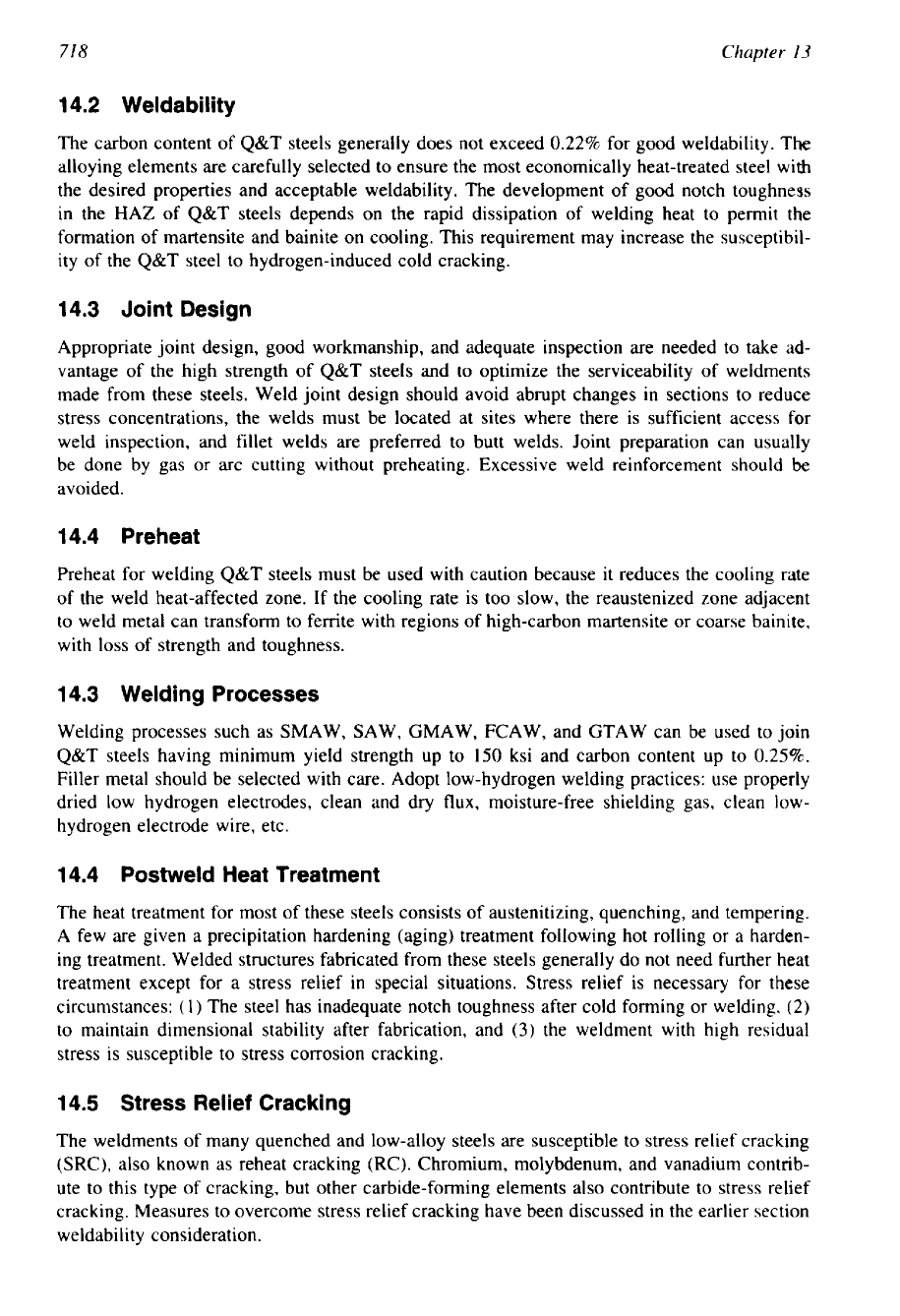
718
Chapter
I3
14.2 Weldability
The carbon content of Q&T steels generally does not exceed 0.22% for good weldability.
The
alloying elements are carefully selected to ensure the most economically heat-treated steel with
the desired properties and acceptable weldability
.
The development of good notch toughness
in the HAZ of Q&T steels depends on the rapid dissipation of welding heat to permit the
formation of martensite and bainite on cooling. This requirement may increase the susceptibil-
ity of the Q&T steel to hydrogen-induced cold cracking.
14.3 Joint Design
Appropriate joint design, good workmanship, and adequate inspection are needed to take ad-
vantage of the high strength of Q&T steels and to optimize the serviceability of weldments
made from these steels. Weld joint design should avoid abrupt changes in sections to reduce
stress concentrations, the welds must be located at sites where there is sufficient access for
weld inspection, and fillet welds are preferred to butt welds. Joint preparation can usually
be done by gas or arc cutting without preheating. Excessive weld reinforcement should be
avoided.
14.4 Preheat
Preheat for welding Q&T steels must be used with caution because it reduces the cooling rate
of the weld heat-affected zone. If the cooling rate is too slow, the reaustenized zone adjacent
to weld metal can transform to ferrite with regions of high-carbon martensite or coarse bainite,
with
loss
of strength and toughness.
14.3 Welding Processes
Welding processes such as SMAW, SAW, GMAW, FCAW, and GTAW can be used to join
Q&T steels having minimum yield strength up to 150 ksi and carbon content up to 0.25%.
Filler metal should be selected with care. Adopt low-hydrogen welding practices: use properly
dried low hydrogen electrodes, clean and dry
flux,
moisture-free shielding gas, clean low-
hydrogen electrode wire, etc.
14.4 Postweld Heat Treatment
The heat treatment for most of these steels consists of austenitizing, quenching, and tempering.
A few are given a precipitation hardening (aging) treatment following hot rolling or a harden-
ing treatment. Welded structures fabricated from these steels generally do not need further heat
treatment except for a stress relief in special situations. Stress relief is necessary for these
circumstances:
(1)
The steel has inadequate notch toughness after cold forming or welding, (2)
to maintain dimensional stability after fabrication, and
(3)
the weldment with high residual
stress is susceptible to stress corrosion cracking.
14.5 Stress Relief Cracking
The weldments of many quenched and low-alloy steels are susceptible to stress relief cracking
(SRC), also known as reheat cracking (RC). Chromium, molybdenum, and vanadium contrib-
ute to this type of cracking, but other carbide-forming elements also contribute to stress relief
cracking. Measures to overcome stress relief cracking have been discussed
in
the earlier section
weldability consideration.
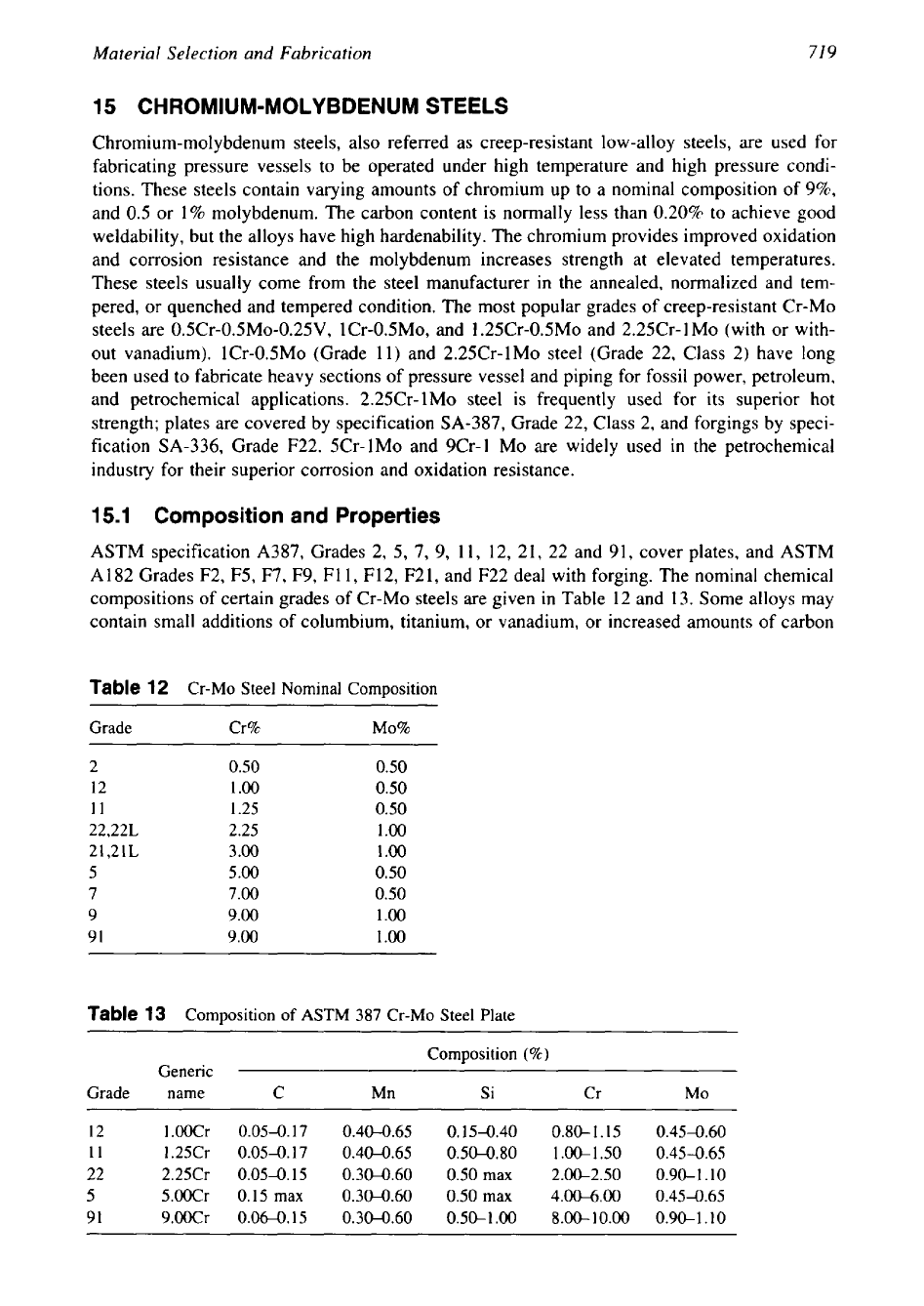
Material Selection and Fabrication
71
9
15
CHROMIUM-MOLYBDENUM STEELS
Chromium-molybdenum steels, also referred as creep-resistant low-alloy steels, are used for
fabricating pressure vessels to be operated under high temperature and high pressure condi-
tions. These steels contain varying amounts of chromium up to a nominal composition of 9%,
and
0.5
or 1% molybdenum. The carbon content is normally less than 0.20% to achieve good
weldability, but the alloys have high hardenability. The chromium provides improved oxidation
and corrosion resistance and the molybdenum increases strength at elevated temperatures.
These steels usually come from the steel manufacturer in the annealed, normalized and tem-
pered, or quenched and tempered condition. The most popular grades of creep-resistant Cr-Mo
steels are 0.5Cr-0.5Mo-0.25V, 1Cr-OSMo, and 1.25Cr-0.5Mo and 2.25Cr-1 MO (with or with-
out vanadium). 1Cr-OSMo (Grade 11) and 2.25Cr-1Mo steel (Grade 22, Class 2) have long
been used to fabricate heavy sections of pressure vessel and piping for fossil power, petroleum,
and petrochemical applications. 2.25Cr-
1Mo
steel is frequently used for its superior hot
strength; plates are covered by specification SA-387, Grade 22, Class 2, and forgings by speci-
fication SA-336, Grade F22. 5Cr-1Mo and 9Cr-1 MO are widely used in the petrochemical
industry for their superior corrosion and oxidation resistance.
15.1
Composition and
Properties
ASTM specification A387, Grades 2, 5,
7,
9, 11, 12, 21, 22 and 91, cover plates, and ASTM
A182 Grades F2, F5,
F7,
F9, F1 1, F12,
F21,
and F22 deal with forging. The nominal chemical
compositions of certain grades of Cr-Mo steels are given in Table 12 and 13. Some alloys may
contain small additions of columbium, titanium, or vanadium, or increased amounts of carbon
Table
12
Cr-Mo Steel Nominal Composition
Grade Cr% MO%
2
0.50
0.50
12
1
.oo
0.50
11
1.25
0.50
22,221,
2.25
1
.oo
21,21L 3
.OO
1
.00
5
5
.OO
0.50
7
7.00
0.50
9
9.00
1
.00
91
9.00
1
.00
Table
13
Composition
of
ASTM
387 Cr-Mo Steel Plate
Composition
(%)
Generic
Grade name C Mn Si Cr MO
12 1.00Cr
0.05-0.17 0.40-0.65
0.15-0.40 0.80-1.15 0.45-0.60
11
1.25Cr
0.05-0.17 0.40-0.65
0.50-0.80
1.00-1.50 0.45-0.65
22 2.25Cr
0.05-0.15 0.30-0.60
0.50
max 2.00-2.50 0.90-1.10
5
5.00Cr 0.15 max 0.30.60
0.50
max 4.00-6.00 0.45-0.65
91 9.00Cr 0.06-0.15 0.30-0.60
0.50-1.00
8.00-10.00 0.90-1.10
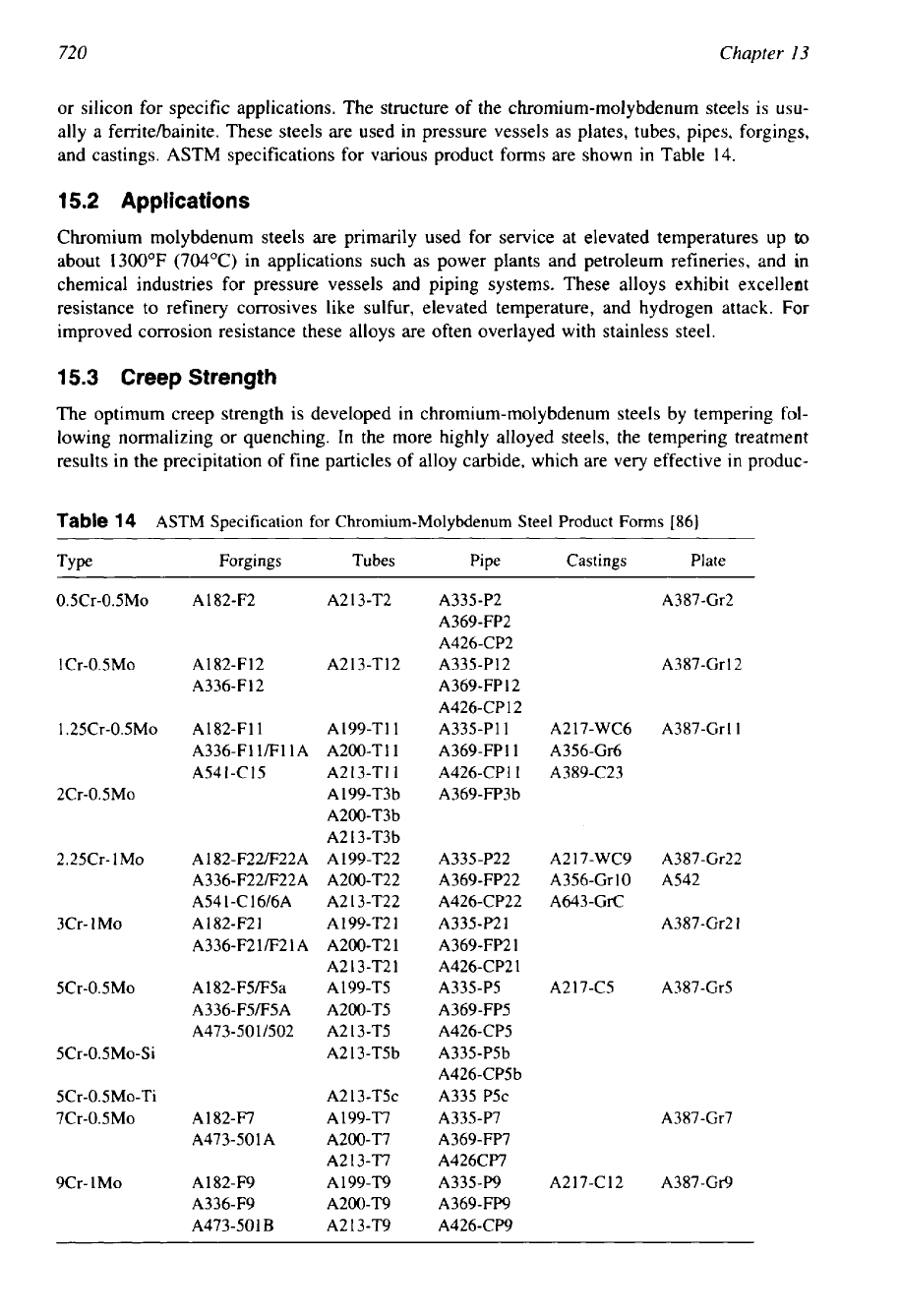
720
Chapter
13
or silicon for specific applications. The structure of the chromium-molybdenum steels is usu-
ally a ferritehainite. These steels are used in pressure vessels as plates, tubes, pipes, forging,
and castings. ASTM specifications for various product
forms
are shown in Table
14.
15.2
Applications
Chromium molybdenum steels are primarily used for service at elevated temperatures up
to
about
1300°F
(704°C) in applications such as power plants and petroleum refineries, and in
chemical industries for pressure vessels and piping systems. These alloys exhibit excellent
resistance to refinery corrosives like sulfur, elevated temperature, and hydrogen attack. For
improved corrosion resistance these alloys are often overlayed with stainless steel.
15.3
Creep
Strength
The optimum creep strength is developed in chromium-molybdenum steels by tempering
fol-
lowing normalizing or quenching. In the more highly alloyed steels, the tempering treatment
results in the precipitation of fine particles
of
alloy carbide, which are very effective
in
produc-
Table
14
ASTM Specification for Chromium-Molybdenum Steel Product Forms [86]
Type Forgings Tubes Pipe Castings Plate
OSCr-OSMo
A 182-F2 A2 13-T2
A335-P2
A387-Gr2
A369-FP2
A426-CP2
1
Cr-OSMo
A 182-F12 A2 13-T12
A335-Pl2
A387-Gr 12
A336-F12
A369-FP 12
A426-CP 12
1.25Cr-0.5Mo
A 182-F11
A199-T11
A335-P11
A217-WC6
A387-Gr
11
A336-F1 l/Fl 1A
A200-T 1 1
A369-FPl l
A356-Gr6
A54 1-C 15
A213-T11
A426-CP11
A389-C23
2Cr-0.5Mo
A 199-T3b
A369-FP3b
A200-T3 b
A213-T3b
2.25Cr-
1
MO
A 182-F22/F22A
A 199-T22
A3 35 -P22
A2 17-WC9
A387-Gr22
A336-F22/F22A
A200-T22
A369-FP22
A356-Gr
10
A542
A54
1
-C 16/6A
A2 13-T22
A426-CP22
A643-GrC
3Cr-
1
MO
A 182-F2
1
A 199-T2
1
A335-P2 1
A387-Gr2
1
A336-F2 1/F2 1 A
A200-T2 1
A369-FP2 1
A2 13-T2 1
A426-CP2
1
5Cr-0.5Mo
A 182-F5/F5a
A 199-T5
A335-P5
A2 17-C5
A387-Gr5
A3 36-F5/F5A
A200-T5
A369-FP5
A473-501/502
A2 13-T5
A426-CP5
5Cr-OSMo-Si
A2 13-T5b
A335-P5b
A426-CP5 b
5Cr-OSMo-Ti
A2 13-T5~
A335 P5c
7Cr-OSMo
A 182-F7 A 199-T7
A335-P7
A387-Gr7
A473-50 1
A
A200-T7
A369-FW
A2 13-T7
A426CF7
9Cr-
1
MO
A 182-F9
A
199-T9
A335-P9
A217-C 12
A387-Gr9
A336-F9 A200-T9
A 369-FP9
A473-501
B
A2 13-T9
A426-CP9
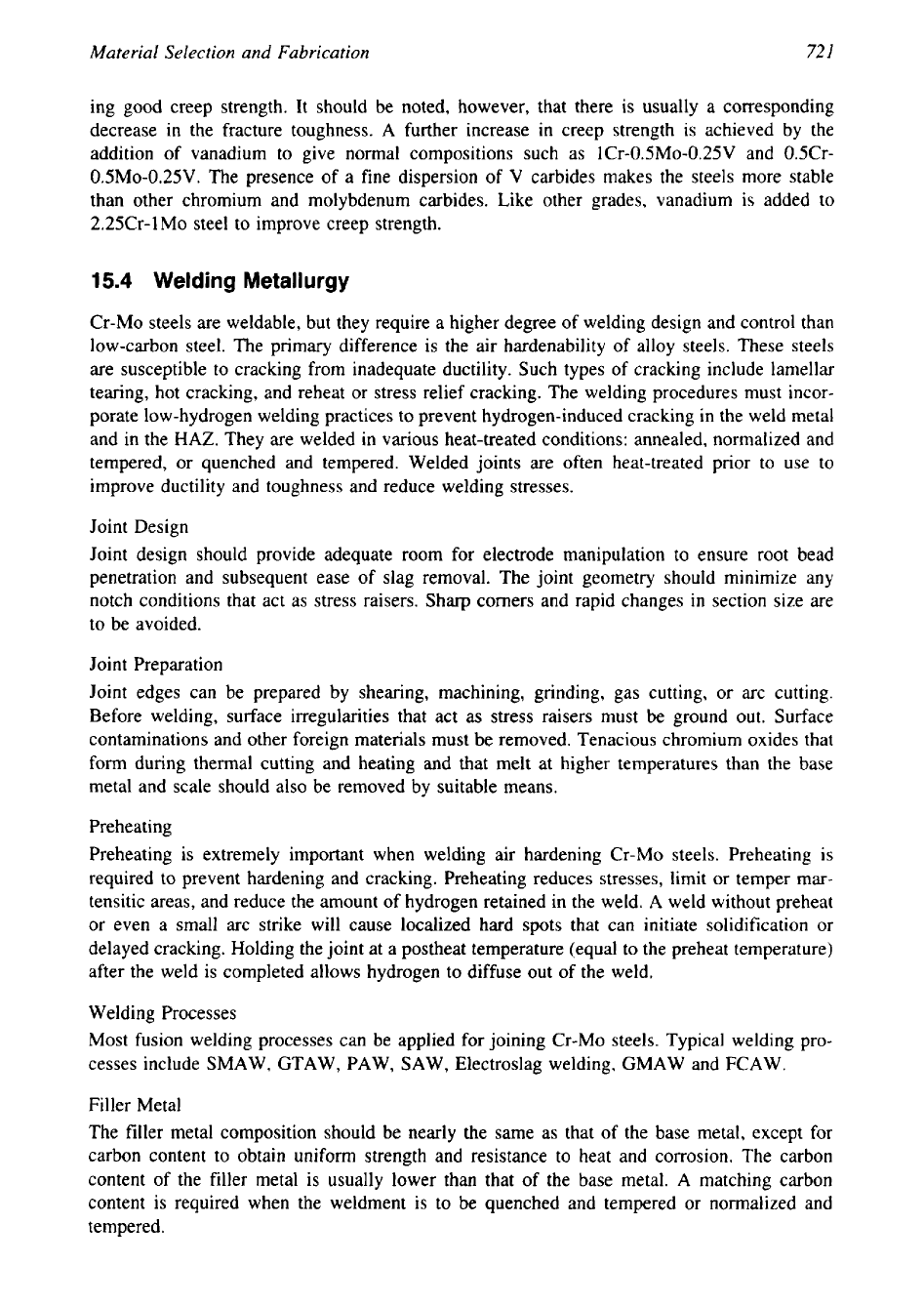
Material Selection and Fabrication
72
I
ing good creep strength. It should be noted, however, that there is usually a corresponding
decrease in the fracture toughness. A further increase in creep strength is achieved by the
addition of vanadium to give normal compositions such as ICr-0.5Mo-0.25V and 0.5Cr-
0.5Mo-0.25V. The presence of a fine dispersion
of
V carbides makes the steels more stable
than other chromium and molybdenum carbides. Like other grades, vanadium is added to
2.25Cr-1
MO
steel to improve creep strength.
15.4
Welding
Metallurgy
Cr-Mo steels are weldable, but they require a higher degree
of
welding design and control than
low-carbon steel. The primary difference is the air hardenability
of
alloy steels. These steels
are susceptible to cracking from inadequate ductility. Such types of cracking include lamellar
tearing, hot cracking, and reheat or stress relief cracking. The welding procedures must incor-
porate low-hydrogen welding practices to prevent hydrogen-induced cracking in the weld metal
and in the HAZ. They are welded in various heat-treated conditions: annealed, normalized and
tempered, or quenched and tempered. Welded joints are often heat-treated prior to use to
improve ductility and toughness and reduce welding stresses.
Joint Design
Joint design should provide adequate room for electrode manipulation to ensure root bead
penetration and subsequent ease of slag removal. The joint geometry should minimize any
notch conditions that act as stress raisers. Sharp corners and rapid changes
in
section size are
to be avoided.
Joint Preparation
Joint edges can be prepared by shearing, machining, grinding, gas cutting, or arc cutting.
Before welding, surface irregularities that act as stress raisers must be ground out. Surface
contaminations and other foreign materials must be removed. Tenacious chromium oxides that
form during thermal cutting and heating and that melt at higher temperatures than the base
metal and scale should also be removed by suitable means.
Preheating
Preheating is extremely important when welding air hardening Cr-Mo steels. Preheating is
required to prevent hardening and cracking. Preheating reduces stresses, limit or temper mar-
tensitic areas, and reduce the amount
of
hydrogen retained in the weld. A weld without preheat
or even a small arc strike will cause localized hard spots that can initiate solidification
or
delayed cracking. Holding the joint at a postheat temperature (equal to the preheat temperature)
after the weld is completed allows hydrogen to diffuse out
of
the weld.
Welding Processes
Most fusion welding processes can be applied for joining Cr-Mo steels. Typical welding pro-
cesses include SMAW, GTAW, PAW, SAW, Electroslag welding, GMAW and FCAW.
Filler Metal
The filler metal composition should be nearly the same as that of the base metal, except for
carbon content to obtain uniform strength and resistance to heat and corrosion. The carbon
content of the filler metal is usually lower than that of the base metal. A matching carbon
content is required when the weldment is to be quenched and tempered or normalized and
tempered.
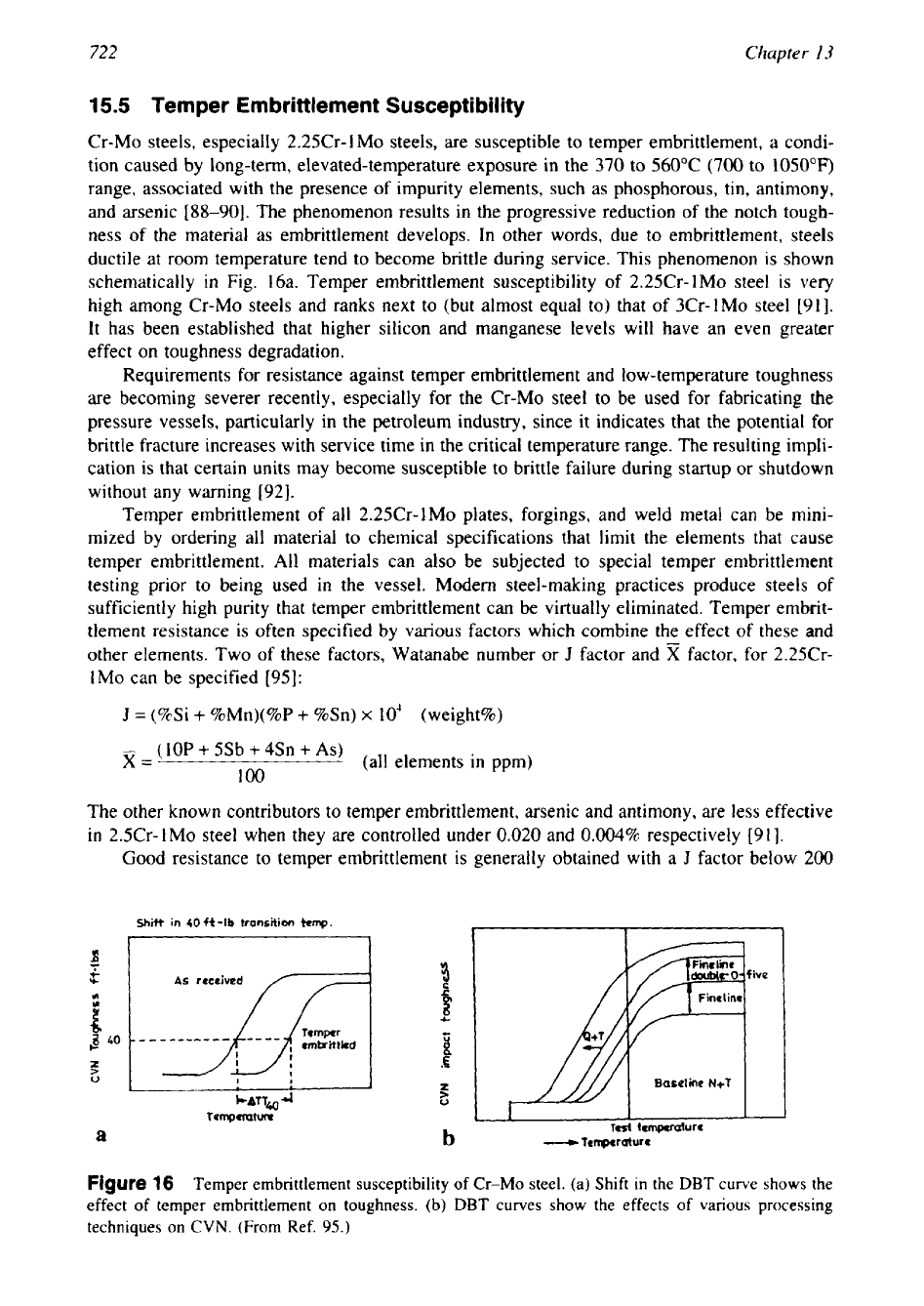
722
Chapter
13
15.5
Temper Embrittlement Susceptibility
Cr-Mo steels, especially 2.25Cr-
1
MO steels, are susceptible to temper embrittlement, a condi-
tion caused by long-term, elevated-temperature exposure in the
370
to 560°C
(700
to 1050°F)
range, associated with the presence of impurity elements, such as phosphorous, tin, antimony,
and arsenic [88-901. The phenomenon results in the progressive reduction of the notch tough-
ness of the material as embrittlement develops. In other words, due to embrittlement, steels
ductile at room temperature tend to become brittle during service. This phenomenon is shown
schematically
in
Fig. 16a. Temper embrittlement susceptibility of 2.25Cr-1Mo steel is very
high among Cr-Mo steels and ranks next to (but almost equal to) that of 3Cr-1Mo steel
[91].
It has been established that higher silicon and manganese levels will have an even greater
effect on toughness degradation.
Requirements for resistance against temper embrittlement and low-temperature toughness
are becoming severer recently, especially for the Cr-Mo steel to be used for fabricating the
pressure vessels, particularly in the petroleum industry, since it indicates that the potential for
brittle fracture increases with service time in the critical temperature range. The resulting impli-
cation is that certain units may become susceptible to brittle failure during startup or shutdown
without any warning [92].
Temper embrittlement of all 2.25Cr-1Mo plates, forgings, and weld metal can be mini-
mized by ordering all material
to
chemical specifications that limit the elements that cause
temper embrittlement. All materials can also be subjected
to
special temper embrittlement
testing prior to being used in the vessel. Modern steel-making practices produce steels
of
sufficiently high purity that temper embrittlement can be virtually eliminated. Temper embrit-
tlement resistance is often specified by various factors which combine the effect
of
these and
other elements. Two of these factors, Watanabe number or
J
factor and
x
factor, for 2.25Cr-
1Mo can be specified [95]:
J
=
(%Si
+
%Mn)(%P
+
%Sn)
x
10'
(weight%)
-
(1OP
+
5Sb
+
4Sn
+
As)
(all elements in ppm)
X=
100
The other known contributors to temper embrittlement, arsenic and antimony, are less effective
in
2.5Cr-!MO steel when they are controlled under 0.020 and
0.004%
respectively [91].
Good resistance
to
temper embrittlement is generally obtained with a
J
factor below 200
shift
in
40ft-lb
transition
temp.
r
I
9
4
Y
As
received
I
/5-
P
---
--------
,a
LO
A-
5
0
1
1
led
temperdurr
a
__L
Tenperatwe
Figure
16
Temper embrittlement susceptibility of
Cr-Mo
steel.
(a)
Shift
in
the
DBT
curve
shows
the
effect
of
temper embrittlement
on
toughness.
(b)
DBT
curves
show
the effects of various processing
techniques
on
CVN.
(From
Ref.
95.)
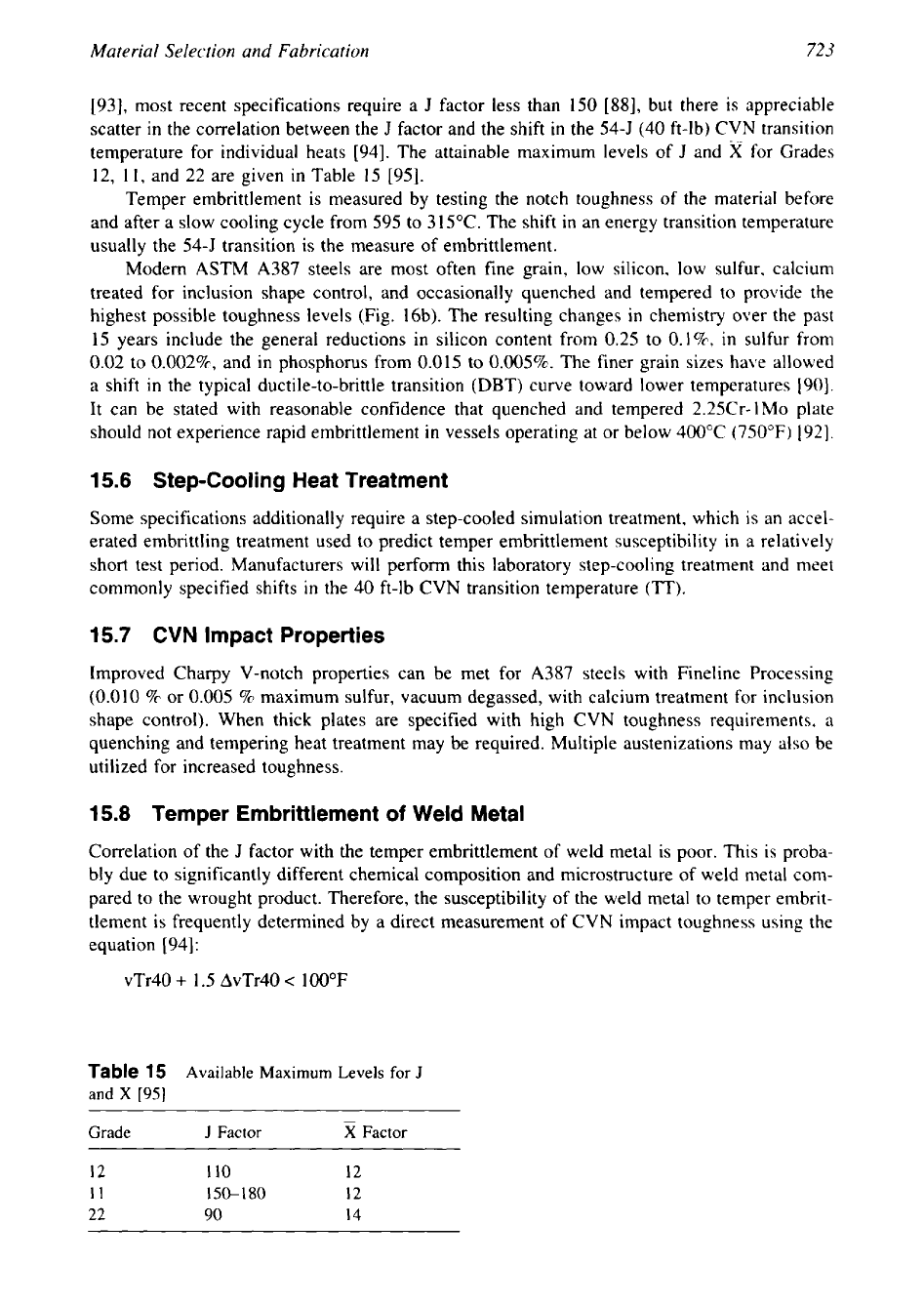
Material Selection and Fabrication
723
[93], most recent specifications require a
J
factor less than 150
[88],
but there is appreciable
scatter
in
the correlation between the
J
factor and the shift
in
the 54-5 (40 ft-lb) CVN transition
temperature for individual heats [94]. The attainable maximum levels of
J
and
X
for Grades
12,
1
1,
and
22
are given
in
Table 15 [95].
Temper embrittlement is measured by testing the notch toughness of the material before
and after a slow cooling cycle from 595 to
3
15°C. The shift
in
an energy transition temperature
usually the 54-5 transition is the measure of embrittlement.
Modern ASTM A387 steels are most often fine grain, low silicon, low sulfur, calcium
treated for inclusion shape control, and occasionally quenched and tempered to provide the
highest possible toughness levels (Fig. 16b). The resulting changes in chemistry over the past
15 years include the general reductions in silicon content from
0.25
to
O.l%,
in
sulfur from
0.02
to
0.002%,
and in phosphorus from 0.015 to 0.005%. The finer grain sizes have allowed
a shift in the typical ductile-to-brittle transition (DBT) curve toward lower temperatures
[90].
It can be stated with reasonable confidence that quenched and tempered 2.25Cr-
1
MO plate
should not experience rapid embrittlement in vessels operating at or below 400°C
(750'F)
[92].
15.6 Step-Cooling Heat Treatment
Some specifications additionally require a step-cooled simulation treatment, which is an accel-
erated embrittling treatment used to predict temper embrittlement susceptibility in a relatively
short test period. Manufacturers will perform this laboratory step-cooling treatment and meet
commonly specified shifts
in
the 40 ft-lb CVN transition temperature (TT).
15.7
CVN
Impact Properties
Improved Charpy V-notch properties can be met for A387 steels with Fineline Processing
(0.010
%
or
0.005
%
maximum sulfur, vacuum degassed, with calcium treatment for inclusion
shape control). When thick plates are specified with high CVN toughness requirements, a
quenching and tempering heat treatment may be required. Multiple austenizations may also be
utilized for increased toughness.
15.8
Temper Embrittlement of Weld Metal
Correlation of the J factor with the temper embrittlement of weld metal is poor. This is proba-
bly due to significantly different chemical composition and microstructure of weld metal com-
pared to the wrought product. Therefore, the susceptibility of the weld metal to temper embrit-
tlement is frequently determined by a direct measurement of CVN impact toughness using the
equation [94]:
vTr40
+
1.5 AvTr4O
c
100°F
Table
15
Available Maximum Levels
for
J
and
X
[95]
-
Grade
J
Factor
X
Factor
12
I10
12
I1
150-1
80
12
22
90
14
